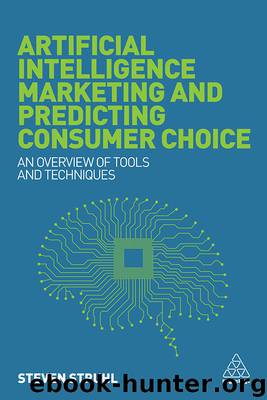Artificial Intelligence Marketing and Predicting Consumer Choice: An Overview of Tools and Techniques by Steven Struhl

Author:Steven Struhl [Struhl, Steven]
Language: eng
Format: azw3
Publisher: Kogan Page
Published: 2017-04-03T04:00:00+00:00
Rounding out the picture
This chapter has become the longest and most complex in this book. First, congratulations for persevering. We have actually omitted much, in particular vast swaths of a more technical nature. Still, we have just a few last topics to consider.
Compensatory versus non-compensatory: what is this all about?
Some criticisms of discrete choice modelling have arisen based on theories that people do not weigh attributes and sum utilities to make decisions. These so-called non-compensatory theories seem perfectly non-objectionable, as we indeed have no clear idea of how decisions get weighed. However, and let us speak plainly here, the argument that this somehow invalidates choice modelling is nonsense.
Some of these criticisms say that people pick certain features first, eliminate choices based on those, and then narrow down in some way. To these critics, this throws into question what people do in choice models.
We understand what these critics are saying and can sympathize with it, but they are wrong. Just because choice modelling presents a product as a set of attributes, this does not force people to weigh and balance everything they are seeing. People indeed can look at the marketplaces presented to them and use any decision strategy that they would use in the actual marketplace.
We can see by watching how people decide that they have different strategies. One part of many studies is sitting with a few people before the formal interviews start and going through the marketplaces. During this phase, you ask people to talk about what they are doing, ask questions and do a great deal of observation. Some people do indeed focus in on a single attribute, such as price or brand, some balance two or three of them, and some make an earnest effort to balance multiple factors.
Discrete choice modelling can accommodate and reflect any of these strategies. The problem with arguments about ‘non-compensatory’ decision making seems to lie in confusing a capability of discrete choice modelling with a requirement of discrete choice modelling. That is, it can model people making complicated decisions where they try to trade all attributes. But that does not mean that anyone has to do that. People can make decisions according to simpler rules and the method will still work accurately.
Download
This site does not store any files on its server. We only index and link to content provided by other sites. Please contact the content providers to delete copyright contents if any and email us, we'll remove relevant links or contents immediately.
Influence: The Psychology of Persuasion by Robert B. Cialdini(4650)
The Miracle Morning by Hal Elrod(4490)
The Hacking of the American Mind by Robert H. Lustig(4257)
Pre-Suasion: A Revolutionary Way to Influence and Persuade by Robert Cialdini(4086)
Unlabel: Selling You Without Selling Out by Marc Ecko(3549)
Ogilvy on Advertising by David Ogilvy(3442)
Hidden Persuasion: 33 psychological influence techniques in advertising by Marc Andrews & Matthijs van Leeuwen & Rick van Baaren(3410)
Purple Cow by Seth Godin(3100)
Who Can You Trust? by Rachel Botsman(3055)
Kick Ass in College: Highest Rated "How to Study in College" Book | 77 Ninja Study Skills Tips and Career Strategies | Motivational for College Students: A Guerrilla Guide to College Success by Fox Gunnar(3033)
This Is Marketing by Seth Godin(2935)
I Live in the Future & Here's How It Works by Nick Bilton(2896)
The Marketing Plan Handbook: Develop Big-Picture Marketing Plans for Pennies on the Dollar by Robert W. Bly(2894)
The Power of Broke by Daymond John(2823)
Building a StoryBrand by Donald Miller(2801)
The 46 Rules of Genius: An Innovator's Guide to Creativity (Voices That Matter) by Marty Neumeier(2717)
Draw to Win: A Crash Course on How to Lead, Sell, and Innovate With Your Visual Mind by Dan Roam(2691)
The Tipping Point by Malcolm Gladwell(2604)
Market Wizards by Jack D. Schwager(2583)
